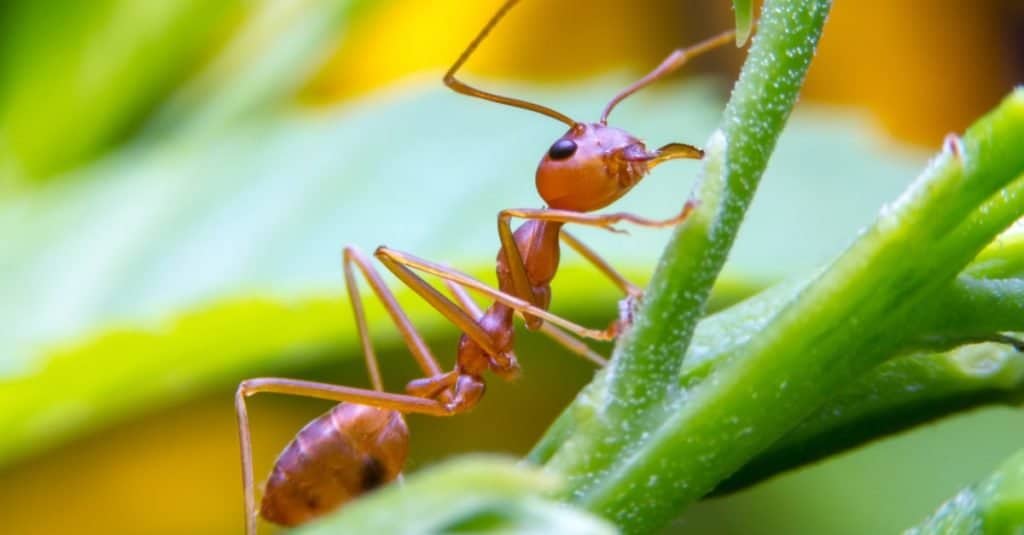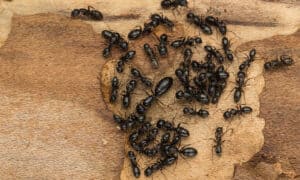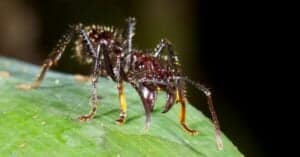When most people think of pests, they imagine insects or rodents that pose minor health risks or simply just annoy homeowners. However, some pests can be harmful on multiple levels. Fire ants are one example. In fact, fire ant infestations can be a huge problem.
These notorious red ants not only inflict a painful bite, but they also disrupt ecosystems and cause a great deal of property damage. Populations are also very hard to control. Read on to discover why fire ant infestations are a multi-billion-dollar problem annually in the United States!
What Are Fire Ants?

, known as the red imported fire ant (RIFA), is an invasive pest that causes a lot of damage.
©Lukas Jonaitis/Shutterstock.com
“Fire ant” is a name given to multiple species of ants within the Solenopsis genus, a group of stinging ants.
Like all mature insects, the adult fire ant has a head, thorax, and abdomen, along with six legs and a pair of antennae. You can distinguish these ants from other local species by their darker abdomen and copper brown head.
Typically, a fire ant colony produces a large mound in an open area. However, sometimes their nests are not visible, as they build them under cover. They feed primarily on young plants, seeds, and insects, while often attacking small animals, such as lizards.
Fire ants deliver a double dose of pain by biting with their mandibles, before stinging from the abdomen. They inject solenopsin, a toxic alkaloid venom that can be very painful. Humans who have experienced it report a sensation similar to burning skin, which gives these ants their name.
Because these ants are more aggressive than most native species, they tend to push native ant species out of their local habitat. They can also be parasites to populations of other insects, such as bees.
Fire ants are resilient and can survive extreme conditions, including flooding and cold temperatures in some cases.
Where Are Fire Ants a Problem?
The majority of fire ant species are not invasive and do not cause problems for people. However, Solenopsis invicta, known as the red imported fire ant (RIFA), is an invasive pest that causes a lot of damage.
These ants are a problem not only in the United States, but also in Taiwan, China, and Australia. The common belief is that these ants were introduced to these countries via shipping crates.
In the case of the United States, the fire ants came from South America. Imported fire ants first made their appearance in the United States around 1930. Now, there are about five times more ants per acre in the United States than in South America.
The United States, Australia, and Taiwan all have national programs to help control fire ant species. However, these have not been successful in eradicating them. Though the Australian program has been somewhat effective, populations remain.
These ants typically populate states in the southeastern United States, including Alabama, Mississippi, Louisiana, South Carolina, Georgia, Florida, and parts of Oklahoma, Texas, Arkansas, Tennessee, Virginia, and North Carolina. They also have limited distribution in New Mexico, California, and Arizona.
Currently, fire ants infest about 300 million acres of land.
Damage Caused by Fire Ants
Fire ants cause damage in many different ways, particularly when the populations are very dense.
Medical Impact on Humans and Animals
As previously mentioned, fire ants have a direct impact on humans. They sting and inject venom, which creates a burning sensation. Red bumps form at the location of the sting, and they become white fluid-filled pustules within a couple of days.
If the person scratches the pustule, it can become infected or cause a scar. In some cases, people become allergic to fire ant venom, and they may even experience anaphylaxis as a result of fire ant stings. This requires emergency treatment and can be fatal.
Anaphylactic shock and mild eczema are more likely in disabled people, the elderly, and young children. Fire ants can also be dangerous to pets and wild animals, causing severe injury or even death.
Impact on Wildlife
Where populations of fire ants are very high, they can have a deleterious effect on populations of native ant species and species of other ground-dwelling insects. They compete with these species for resources and can sometimes push them out of their environments.
These ants can directly prey upon other animals. They have been known to attack the nestlings of ground-nesting birds and even climb trees to enter bird nests.
Impact on Agriculture

Fire ants can feed on the fruits and buds of multiple crop plants, including citrus, okra, soybean, and corn.
©wnarong/Shutterstock.com
The large mounds that fire ants build in the ground are not only visually unpleasant, but they can also cause damage to combines and mowers.
Fire ants can feed on the fruits and buds of multiple crop plants, including citrus, okra, soybean, and corn. They can also hinder the development of young trees.
Though fire ants have negative effects on some insect populations, they also encourage population growth of sucking insects, such as mealy bugs, scales, and aphids. Unfortunately, these particular insects are also responsible for crop damage.
Sucking insects produce honeydew, a sugary liquid on which fire ants feed. The ants do not harm these insects and in fact help their populations thrive, increasing the need for insecticide use.
Impact on Property
In addition to their impact on fieldwork machinery, fire ants can interfere with the functioning of electrical equipment. They can interfere with switching mechanisms, build their nests in utility boxes, and chew on insulation. They are capable of invading electric equipment, causing failures and short circuits.
If fire ants invade a building, they can cause significant structural damage. It is not uncommon for them to build their nests in the walls of structures.
These ants are also notorious pests for turfgrass managers who are trying to maintain the lawns of sporting pitches, such as golf courses.
Secondary Effects
Secondary negative effects of fire ant populations come from efforts to control them. For example, when insecticides are misused or overused, it can lead to contamination of surface runoff water.
The Overall Economic Impact of Fire Ant Infestations
Imported fire ants cost the United States an estimated 6.7 billion dollars every year. The FDA estimates that more than five billion dollars are spent annually on damage, medical treatment, and control efforts in areas of infestation. In addition to this, these ants cause about 750 million dollars of damage each year to agricultural assets.
The photo featured at the top of this post is © sarawuth wannasathit/Shutterstock.com
Thank you for reading! Have some feedback for us? Contact the AZ Animals editorial team.






